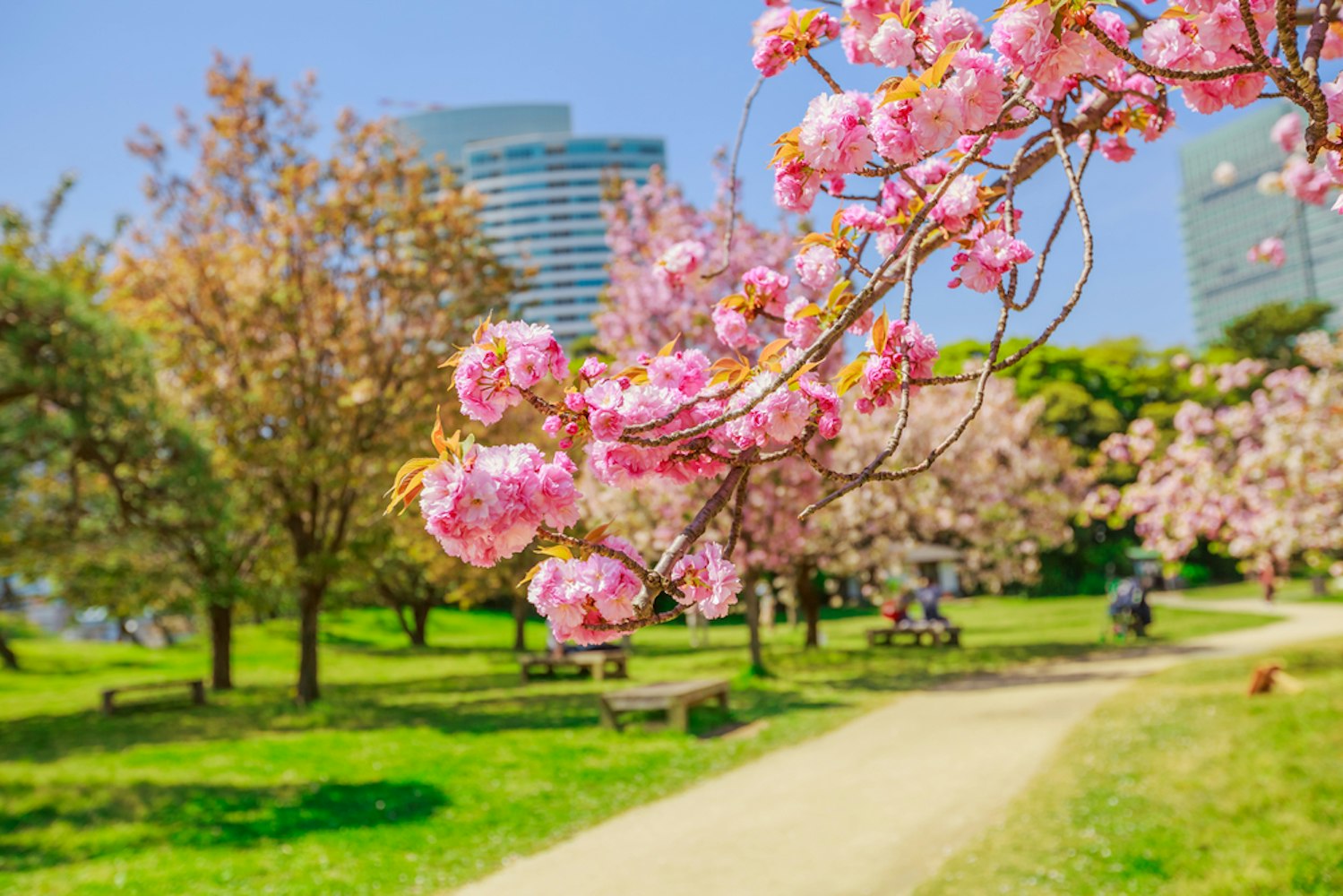

ตั้งอยู่ท่ามกลางมหานครที่คึกคักของ โตเกียว, สวนฮามะริคิวคือข้อพิสูจน์ที่สงบต่อประวัติศาสตร์อันยาวนานและความชื่นชมในความงามตามธรรมชาติของเมือง ในบทความนี้ เราจะเจาะลึกถึงประวัติศาสตร์ของสวนฮามะริคิว วิธีการไปที่นั่นผ่านระบบขนส่งที่มีประสิทธิภาพของโตเกียว สิ่งที่คุณสามารถทำได้เมื่อคุณมาถึง และสุดท้ายสรุปด้วยเหตุผลว่าทำไมสถานที่ที่งดงามนี้จึงเป็นจุดหมายปลายทางที่คุ้มค่ากับการเยี่ยมชมสำหรับทั้งคนท้องถิ่นและนักท่องเที่ยว

เยี่ยมชมสวนฮามาริคิวรวมถึงสถานที่สำคัญอื่น ๆ ในโตเกียว
สวนฮามะริคิว ซึ่งรู้จักในนามสวนฮามะริคิวออนชิ (浜離宮 恩賜 庭園) ในภาษาญี่ปุ่น มีประวัติศาสตร์ที่ยาวนานหลายศตวรรษ โดยแต่เดิมแล้วเป็นวิลล่าที่เป็นของ โชกุนโตกุงาวะ ในยุคเอโด ทำหน้าที่เป็นที่พักผ่อนจากความต้องการของการเมือง
ความแตกต่างที่ชัดเจนระหว่างอาคารสูงของเมืองและโอเอซิสที่เงียบสงบของฮามะริคิวช่างน่าทึ่งและสะท้อนให้เห็นถึงเสน่ห์ที่ยังคงอยู่ของสถานที่นี้ หนึ่งในคุณสมบัติที่น่าจดจำที่สุดของสวนคือสระน้ำขนาดใหญ่ ชิโออิริ โน อิเกะ ซึ่งเชื่อมต่อโดยตรงกับอ่าวโตเกียว
การเชื่อมต่อนี้ทำให้สามารถชมวิวทะเลที่งดงามและช glimpsing ไปยังการจัดสวนแบบญี่ปุ่นดั้งเดิมที่ได้รับการอนุรักษ์มาเป็นเวลาหลายศตวรรษ ชื่อภาษาญี่ปุ่นของสวนฮามะริคิวสะท้อนถึงมรดกของมัน โดยที่ "ฮามะ" หมายถึงชายหาดและ "ริคิว" หมายถึงการเชื่อมโยงกับจักรพรรดิในฐานะออนชิเทียน หรือสวนที่ได้รับการกำหนดเพื่อความเพลิดเพลินของราชวงศ์
การเข้าร่วมกิจกรรมที่หลากหลายทำให้คุณสามารถดื่มด่ำกับความงดงามที่มีเสน่ห์และบรรยากาศที่เงียบสงบของสวนฮามะริคิวซึ่งเป็นสมบัติอันแท้จริงที่ตั้งอยู่ใจกลางของโตเกียว นี่คือสิ่งที่ต้องทำในสวนฮามะริคิว:

สวนฮามะริคิวกลายเป็นการแสดงที่น่าหลงใหลในต้นเดือนเมษายนด้วยความสดใสของ ซากุระ. ช่างภาพและคนรักธรรมชาติจะพบว่าช่วงเวลานี้เหมาะสำหรับการจับภาพความงามที่บอบบางของดอกไม้สีชมพูและสีขาว
ภูมิทัศน์ของสวนจะเปลี่ยนไปเป็นภาพที่งดงาม มอบความบันเทิงให้กับสายตา มันคือช่วงเวลาที่แก่นแท้ของฤดูใบไม้ผลิมีการแสดงออกอย่างชัดเจน ทำให้มันกลายเป็นจุดหมายปลายทางที่ต้องเยี่ยมชม

พิจารณากำหนดเวลาการเยี่ยมชมของคุณที่สวนฮามะริคิวในปลายเดือนพฤศจิกายนซึ่งเป็นช่วงที่สวนเต็มไปด้วยสีอบอุ่นของฤดูใบไม้ร่วง ขณะที่คุณเดินเล่นไปตามทางเดิน คุณจะถูกล้อมรอบด้วยพาเลตสีสดใสของสีแดง สีส้ม และสีเหลือง
การเปลี่ยนแปลงนี้สร้างบรรยากาศที่เงียบสงบและสวยงาม เหมาะสำหรับการเดินเล่นอย่างสบาย ๆ ใบไม้หลากสีในฤดูใบไม้ร่วงให้ฉากหลังที่สมบูรณ์แบบสำหรับการพักผ่อนและการถ่ายภาพ

สัมผัสประสบการณ์การดื่มชาญี่ปุ่นแบบดั้งเดิมที่บ้านชานNakajima ซึ่งเป็นจุดเด่นของสวนฮามะริคิว บ้านชานที่ไม่เหมือนใครนี้ตั้งอยู่บนเกาะสวยงามกลางสระน้ำที่เงียบสงบ
คุณจะได้สัมผัสกับบรรยากาศที่สงบสุขขณะที่คุณจิบชาดั้งเดิม บ้านชาน มอบวิวทิวทัศน์ที่สวยงามของสวนรอบ ๆ เพิ่มความสงบสุขในระหว่างการเยี่ยมชมของคุณสำรวจสถานที่ทางประวัติศาสตร์

สถานที่เหล่านี้มอบภาพมุมมองที่ไม่เหมือนใครและน่าสนใจเกี่ยวกับประวัติศาสตร์ที่ร่ำรวยและมรดกทางวัฒนธรรมของโตเกียว การอนุรักษ์ของพวกเขาภายในสวนสองฝั่งเชื่อมช่องว่างระหว่างประวัติศาสตร์อันสดใสของเมืองกับภูมิทัศน์อันโมเดิร์น
เดินเล่นไปตามสระน้ำทะเล

สวนฮามะริคิวมีความโดดเด่นจากสระน้ำทะเลที่เป็นเอกลักษณ์ ซึ่งระดับน้ำจะเปลี่ยนแปลงไปตามน้ำขึ้นน้ำลงของมหาสมุทร คุณสมบัตินี้เพิ่มความเคลื่อนไหวให้กับสวน ทำให้แตกต่างจากการออกแบบสวนญี่ปุ่นทั่วไปการเดินเล่นไปใกล้กับสระน้ำที่เปลี่ยนแปลงอยู่ตลอดเวลาทำให้เกิดประสบการณ์ที่สอดคล้องและพิเศษ ระดับน้ำที่เปลี่ยนแปลงเป็นโอกาสให้นักท่องเที่ยวมองเห็นความกลมกลืนระหว่างธรรมชาติกับการจัดสวนแบบดั้งเดิม
เพลิดเพลินกับพืชพันธุ์ตามฤดูกาล

เมื่อฤดูใบไม้ผลิเปลี่ยนเป็นฤดูร้อน ภูมิทัศน์จะมีสีสันสดใสด้วยสีสันที่เข้มข้นของดอกไอริส ทุกฤดูกาลจะเปลี่ยนสวนไปในแบบที่ไม่เหมือนใคร ทำให้มีเสน่ห์และความงามที่แตกต่างกัน
เข้าร่วมกิจกรรมทางวัฒนธรรม

เทศกาลต่าง ๆ ที่จัดขึ้นภายในสวนฮามะริคิว การรวมกลุ่มเหล่านี้มักจะมีการแสดงทางธรรมเนียมที่น่าหลงใหล สะท้อนวัฒนธรรมที่ร่ำรวยของญี่ปุ่นการสาธิตแบบโต้ตอบและการทำเวิร์กช็อปแบบลงมือช่วยมอบประสบการณ์การเรียนรู้ที่ไม่เหมือนใคร กิจกรรมเหล่านี้เป็นจุดเด่นสำหรับนักท่องเที่ยวที่ต้องการเข้าใจวัฒนธรรมญี่ปุ่นอย่างลึกซึ้ง
ดูนก

นักท่องเที่ยวสามารถใช้เวลาที่อยู่ใกล้กับสระน้ำเหล่านี้ มองดูและระบุชนิดต่าง ๆ ในที่อยู่อาศัยตามธรรมชาติ มันทำให้สวนเป็นจุดหมายปลายทางที่เหมาะอย่างยิ่งสำหรับผู้ที่ชื่นชอบการดูนกและคนรักธรรมชาติ
ผ่อนคลายในความสงบ

ให้สิ่งแวดล้อมที่เงียบสงบนี้โอบกอดคุณ มอบการพักผ่อนจากความวุ่นวายของเมือง คุณสามารถสะท้อนและฟื้นฟูในสภาพแวดล้อมที่เงียบสงบนี้ ห่างไกลจากความวุ่นวายของเมือง
สถานีชินบาชิJRอยู่ห่างไปเพียง 12 นาทีในการเดิน offering เส้นทางที่ตรงไปตรงมาสำหรับผู้ที่ใช้การรถไฟญี่ปุ่นสำหรับผู้ที่ชื่นชอบรถไฟใต้ดิน สายรถไฟใต้ดินโอเอโดและสายยูลิคามอเม่มีการเดินทางที่รวดเร็วไปยังสวนฮามะริคิว จากสถานีชิโดเมะใช้เวลาเพียงเจ็ดนาที ทำให้คุณสามารถเข้าถึงโอเอซิสที่เงียบสงบในใจกลางโตเกียวได้อย่างง่ายดาย
สวนฮามะริคิวในโตเกียว: โอเอซิสแห่งธรรมชาติและประวัติศาสตร์

สำหรับผู้ที่ต้องการการเดินทางที่สะดวกสบาย สามารถเข้าถึงสวนนี้ได้ด้วยรถส่วนตัว
ไม่ว่าคุณจะเยี่ยมชมในช่วงฤดูซากุระ ใบไม้เปลี่ยนสีในฤดูใบไม้ร่วงตั้งแต่กลางเดือนพฤศจิกายน ซึ่งมีจุดพีคระหว่างปลายเดือนพฤศจิกายนและต้นเดือนธันวาคม หรือเวลาใดของปี สวนฮามะริคิวจะนำเสนอประสบการณ์ที่เงียบสงบที่ทำให้คุณสามารถผ่อนคลายและชื่นชมวิวที่งดงามของอ่าวโตเกียว คว้าโอกาสเพื่อสำรวจไข่มุกที่ซ่อนอยู่ในโตเกียว ที่ซึ่งประเพณีหลายศตวรรษมาพบกับภูมิทัศน์เมืองสมัยใหม่ สร้างโอเอซิสที่สมดุลสำหรับทุกคนที่จะเพลิดเพลิน
Whether you visit during cherry blossom season, autumn foliage from the middle of November, peaking between late November and early December, or any time of the year, Hama Rikyu Gardens promises a serene experience that allows you to relax and unwind while taking in the stunning views of Tokyo Bay. Take the chance to explore this hidden gem in Tokyo, where centuries of tradition meet the modern cityscape, creating a harmonious oasis for all to enjoy.



